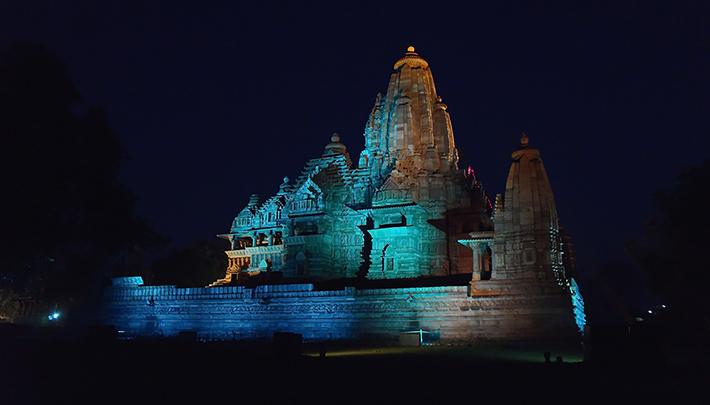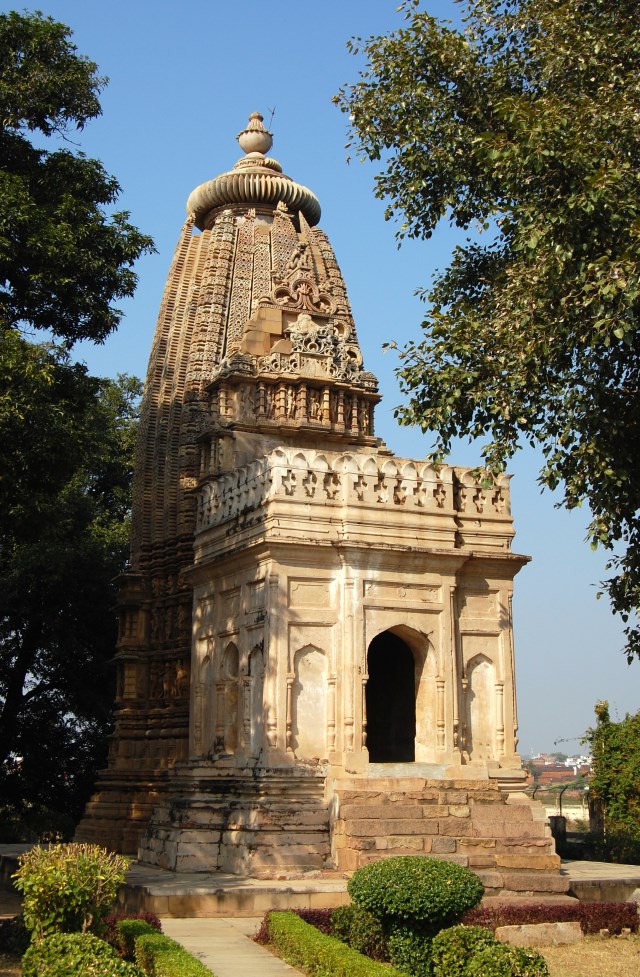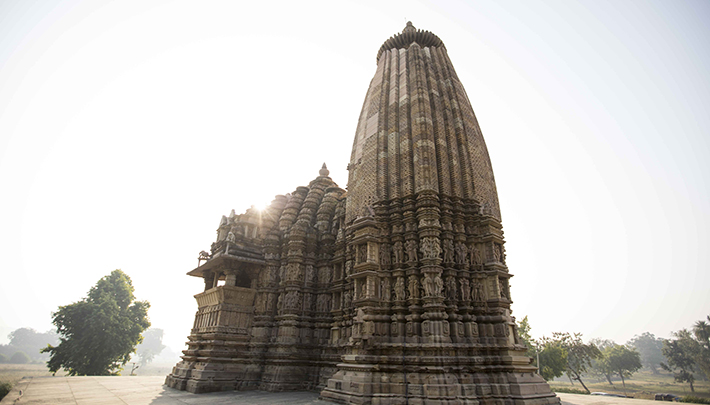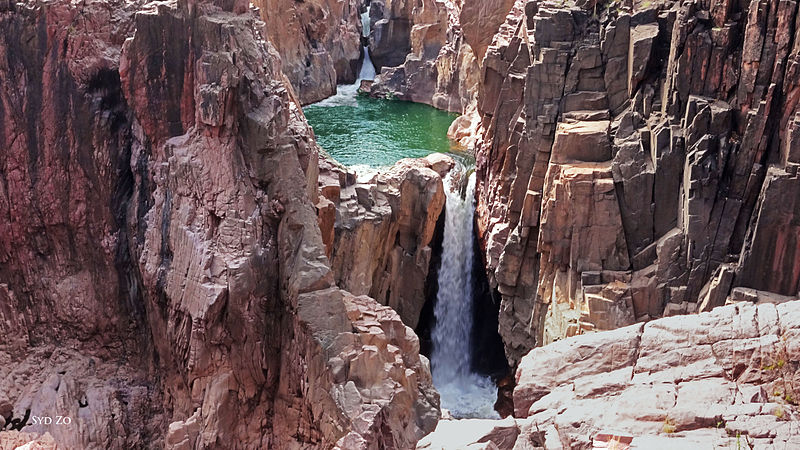KHAJURAHO- Places to visit
Life, in every form and mood, has been captured in stone, testifying not only to the craftsman’s artistry but also to the extraordinary breadth of vision of the Chandela Rajputs under whose rule the temples were conceived and constructed. Khajuraho is one of the most popular tourist spots in Madhya Pradesh which is famous for its ancient temples that depict some of the finest art in the world. These temples of Khajuraho are India’s unique gift to the world, representing creativity that is perfect in execution and sublime in expression.
The name Khajuraho is derived from its Sanskrit nomenclature ‘Kharjuravahaka’ which is the confluence of two Sanskrit words ‘Kharjur’ meaning date palm and ‘Vahaka’ meaning bearer. Built between 950-1050 AD by the Chandela Dynasty, these temples depict various forms like meditation, spiritual teachings, kinship, wrestling, royalty and most significantly, erotic art. The temples consist of stunning displays of fine sculptures and exceptional architectural skill, making them one of the UNESCO World Heritage Sites in India. Of the 85 original temples, 22 have survived till today to constitute one of the world’s greatest artistic wonders.
HISTORY OF KHAJURAHO
There are various legends or stories regarding the history of Khajuraho and its sculptures linked to spiritual beliefs. One such legend is this that the moon always evokes romance and it is of little wonder that the descendants of the celestial moon God would build monuments that stand for love. Hemwati, the lovely young daughter of a Brahmin priest, was seduced by the moon God while bathing in a forest pool. She ran into the forests for refuge and raised her son, Chandravarman (founder of Chandela Dynasty) alone. Brought up in the forests by his mother who seeked refuge from a censorious society, Chandravarman, when established as a ruler, had a dream visitation from his mother. It is said that she implored him to build temples that would reveal human passions and in doing so bring about a realisation of the emptiness of human desire.
Why was Khajuraho, a small village back then, chosen is still open to speculation but one theory that supports is given the nature of their faith in temples, the Chandelas conceived Khajuraho as a seat of learning and religion to bring together many sects. Thus, with their decline and these temples that lay forgotten for many centuries and covered by encroaching forests were rediscovered in 1830 by T.S. Burt who restored and cleaned the temples of Khajuraho that once again testify to a past glory.
Based on their orientation, the temples are categorised into three groups: Western, Eastern and Southern. These temples are dedicated to several Hindu Gods and Goddesses along with deities in Jain beliefs. Among the temples that are standing till now, 6 are dedicated to Lord Shiva, 8 to Lord Vishnu, 1 each to Lord Ganesha and the Sun God, while 3 are dedicated to Jain Tirthankaras. The largest of the temples is the Kandariya Mahadeo Temple that is dedicated to the glory of lord Shiva which makes Khajuraho one of the four holy sites dedicated to the glory of Lord Shiva. Beautiful, intricate and expressive, the sculptures of the Khajuraho temples will leave you in awe and wonder.
1. WESTERN GROUP OF TEMPLES
The Western side of the temples are the most popular area, which is also the richest and largest among other groups.
1. Khandariya Mahadeo or Mahadeva: This temple, dedicated to Lord Shiva is the largest of the temples in Khajuraho and was built during the rule of King Gandadeva between 1017 and 1029 CE. The elegant proportions of this building and its sculptural detailing are the most refined examples of the artistic heritage of central India. Approximately 800 sculptures are carved on the interior and exterior walls of this magnificent temple. The lintels of the sanctum and the doorjambs have rich floral carvings. Inside the sanctum stands a Shivlinga. Three bands of sculptures on the outer walls depicts Gods & Goddesses & mythical beasts. Other themes of sculpture in the temple include warriors, hunters, dancers, musicians, devotees etc.

2. Devi Jagdamba Temple: Devi Jagdamba Temple is a famous shrine of Khajuraho. The Garba Griha of the temple is dedicated to the goddess of the Universe, Devi Jagdamba. The walls of the temple are carved skillfully to create beautiful images. It is believed that this temple was originally dedicated to Lord Vishnu and later to Goddess Parvati and then to Goddess Kali. The temple is a splendid representation of three-part design. The design has similarity with the Chitragupta Temple. An important feature of the temple is that the temple stands on a sanctum which has no space for walking. Visitors coming to the temple feel awed by the various skillful carvings on the walls. Such a rich heritage of architectural design and depiction is rarely seen elsewhere. A visit to Khajuraho cannot be complete without paying a visit to this beautiful temple.

3. Chousath Yogini: This is the only granite temple and the earliest surviving shrine in the Khajuraho group. Chousath Yogini Temple is dedicated to 64 Yoginis, who are the manifestations of the Mother Goddess Shakti. It was built around 875-900 AD and belongs to the western group of temples. The design of the temple is simple and without any ornamental decorations. The walls lack the characteristic carvings of the Khajuraho temples. Of 65 shrines, only 35 shrines remain in this temple. This temple is one of the oldest Yogini temple in India.

4. Chitragupta Temple: The Chitragupta temple (also known as Bharatjis temple) is an 11th century temple dedicated to Surya, the Sun God. The temple walls depict an artistic profusion of sculpture of Gods, Goddesses, apsaras and amorous couples. One of the main attractions of the temple is the splendid idol of Surya Deva standing on a chariot driven by seven beautiful horses. The walls of the temple have intricate carvings on them. Among other attractions of the temple the prime ones are of full-fledged figures of Surasundaris in stone carvings and the magnificent carving of Lord Vishnu with Eleven Heads.

5. Vishwanath Temple: Viswanath Temple is dedicated to the Hindu deity, Lord Shiva. This temple, built by Dhanga Deva, belongs to the western group of temples. This temple was built in the structure of Panchayatan temple, in which four additional shrines at four corners surround the main shrine standing in the middle. The temple depicts more than 600 rock images and also has an impressive sculpture of Lord Brahma enshrined inside the temple. The interior of the temple contain some of the well known sculptures of Khajuraho, like a lady playing the flute, a mother with her child and another lady painting her toenails. The beauty of the temple lies in the depiction of the exquisite figures of women on the rock walls. The magnificent carvings on the external walls of the temple add charm to its structural beauty.

6. Lakshmana Temple: Lakshmana Temple is a temple made in honour of Lord Vishnu. It is a splendid structure designed in stone. It was built in 930–950 AD.The temple houses more than 600 images of Hindu deities. The Lakshmana Temple is a Panchayatan style of temple, meaning there are four shrines at the corners of the courtyard. Each shrine has a bordered fence carving. The skilled and beautiful craftsmanship of the workers is thoroughly visible in the various images present in the temple. The temple also has figures of full-fledged women standing in different postures and wearing ornaments. The striking Lakshmana Temple is one of the three largest temples of Khajuraho and the western group of temples. It is considered to be the earliest temple (954 AD) to have been built by the Chandela rulers.

7. Matangeswara Temple: The temple of Matangeswara was built by the Chandela dynasty ruler Chandra Dev in the early 10th century AD. The Matangeswara Temple is a temple dedicated to the Hindu deity, Lord Shiva. The temple has a magnificent and huge 8 ft high Shivalingam. Large crowds gather in this temple during the yearly festival of Mahashivratri. This lingam made of yellow sandstone has the distinction of being one of the largest lingams to be found in the northern part of the country. The sandstone has been polished to give the lingam an attractive lustre. This ancient temple was one of the first ones to be built at Khajuraho. The temple is situated near the Lakshmana Temple but has no fence or enclosure to block its access. Although the temple is comparatively plain in design to the others, it is a very popular one.

8. Sound & Light Show: This fascinating Sound & Light spectacle evokes the life and times of the great Chandela kings and traces back in time stories of the unique temples during the 10th and 11th century. This 50 minute event is mounted in the complex of the Western Group of temples & narrated by Mr. Amitabh Bachchan who takes us through the different stories, temples and the history of Khajuraho in his mesmerising voice.

2. EASTERN GROUP OF TEMPLES
The Eastern Group of Temples in Khajuraho are quite different from the other temples and are mainly dominated by Jain temples.
1. Parsvanath Temple: Parsvanath Temple is a magnificent structure that belongs to the eastern group of temples situated in Khajuraho which is the largest Jain temples existing in India today. This temple was built in 954 AD and is dedicated to the Jain tirthankaras. This temple was built in honour of Adinath, the first Jain tirthankara. The temple is decorated with sculptures and inscriptions and the grand architecture of the temple is a visual delight in itself. The temple houses an idol of Parsvanath. An interesting aspect of this temple is that it has gained fame in spite of the absence of sensual sculptures of men and women.

2. Ghantai Temple: Ghantai Temple is a Jain temple belonging to the Eastern group of temples which was constructed around 950-1050 AD. Ghantai means bell and the name has been given because of the carvings of bells depicted on the pillars of the temple. The temple is famous for the depiction of the frieze that describes the 16 dreams of Mahavira’s mother. The temple also depicts a multi armed Jain deity riding on a winged Garuda. That is why this temple is regarded highly by the people belonging to the Jain religion.

3. Adinath Temple: Adinath Temple was built by the rulers of the Chandela dynasty in the 11th century and was dedicated to the Jain saint Adinath. The temple is decorated by a single towered shikara, which increases the beauty of the shrine. Several figures of various categories of women like Nayikas, Kaminis and Bhaminis are carved on the walls.

There are three Hindu Temples in the Eastern Group as follows:
a) The Brahma:
The Brahma Temple lies by the banks of the biggest tank in Khajuraho known by the name Ninora Tal. The temple was constructed in 900 AD and contains carved depictions of Lord Brahma, Lord Vishnu and Hindu deities. The temple is a small one with a square shape built on twelve granite pillars which gives the temple an elevated platform at a height of 11 feet. The grand roof is built from sandstone. The temple is mainly built from granite. Every side of the temple is projected prominently with beautiful carvings which increase the beauty of the temple. The inner sanctum of the temple has a Shiva lingam that indicates the temple was dedicated to Lord Shiva.

b) The Vamana:
The Vamana Temple was constructed in the period of 1050-1075 AD. The temple was built to honour Vamana or the dwarf incarnation of the Hindu deity, Lord Vishnu. This temple holds strong similarities in structure to the Adinatha Temple. The Vamana Temple also has a shikara and a maha-mandapa to decorate the temple’s structure. The exterior walls are adorned by carvings of apsaras in a variety of sensuous attitudes.

c) The Javari:
The Javari Temple is a unique presentation of the Khajuraho tourism which is situated near the Brahma Temple and belongs to the eastern group of Khajuraho temples. The temple is of a smaller size in comparison to the other temples. This grand temple has been dedicated to the Hindu deity, Lord Vishnu. This temple was constructed between 1075 and 1100 AD and it portrays the ancient Khajuraho architectural style. Another important feature of this temple is the decoration of the external walls. The walls depict several wonderful carvings in elaborate details. The entrance to the temple is rightly balance by huge carved towers.

3. SOUTHERN GROUP OF TEMPLES
The Southern group of temples in Khajuraho is located slightly away from the other groups of temples.
1. Duladeo Temple: Duladeo temple also known as “Kunwar Math” is the most popular temple in the southern group of temples in Khajuraho. This temple is dedicated to Lord Shiva and is dated in 1100-1150 AD. Shiva is known as the Dulhadev here meaning the holy bridegroom. A temple dedicated to Shiva the entire temple is decorated with carvings of Shiva and his consort Parvati. Historians hold it to be the last of the temples built by the Chandelas.

2. Chaturbhuj Temple: Chaturbhuj Temple was built in 1100 AD. The temple has an elaborate entrance with a carved doorway depicting the sculptures of Brahma, Vishnu and Mahesh, the powerful trio of the Hindu religion. The main attraction of the temple is a carved image of Lord Vishnu having 4 arms and a huge height of 9 feet.

3. Beejamandal Temple: The splendid architecture of the Beejamandal Temple displays an Indonesian or south-east Asian style. There is a tradition of lighting a holy lamp in this temple each night and so has been a practice of the villagers staying near the temple to light the holy oil-lamp every night inside the temple complex. The temple was originally built to honour and worship the Hindu deities, Lord Shiva and Goddess Parvati. Currently in ruins, but from the remaining structure it can be seen that the temple had highly decorated exterior walls. These walls had carvings of various animals. The interiors of the temple had carved images of human forms in several vivid postures.

EXCURSIONS AND OTHER ACTIVITIES
1. Panna National Park: Panna National Park is a National Park located 32km away and only a half an hour drive from Khajuraho. The jungle harbours many wildlife species such as leopard, wolf and gharial. Herds of chinkara, sambhar and bluebell are a common sight. Panna was given the Award of Excellence in 2007 as the best maintained national park of India by the Ministry of Tourism of India. The spectacular Pandav Falls are enroute to the National Park. Other places one can visit are the Benisagar Dam, Raneh Falls and Ranguan Lake.

2. Raneh Falls: Raneh Falls is on the majestic Ken River. The main attraction here is the Canyon of Crystalline Granite that is 5km long and 100 feet deep. The canyon is created from pure crystalline granite that display various shades of colours ranging from pink to red and sometimes white, green and grey also. A number of waterfalls of various sizes plunge into the canon. Raneh Falls flows adjacent to the Panna National Park. The greenery of the forest and the gleaming water of the falls make for a picturesque view.

3. State Museum of Tribal and Folk Arts: This Museum showcases a fine collection of the masterpieces of tribal and folk arts, artifacts etc from all over Madhya Pradesh on display at the Chandela Cultural Complex. This State Museum has more than 500 representative items of terracotta, metal craft, woodwork, tribal and folk paintings, tattoos, jewellery and masks on display.

4. Dhubela Palace: This Palace was built in 17th-18th century A.D. by Maharaja Chhatrasal and is just 65kms north-west of Khajuraho. Thin bricks, sand and lime were used to construct the palace. Currently converted to a Museum which is housed inside an old fort it comprises of 8 galleries, of which two galleries display inscriptions, copper plates, Sati pillars, lingas and inscribed images of the Gupta and Kalachuri period. The sculptures showcased in the museum are from the Shakti cult. It also displays the garments, weapons and paintings of the Bundela kings. The museum mainly depicts the history, rise and fall of the famed Bundela dynasty of Khajuraho. It is a good place to stop on the drive from Orchha to Khajuraho.

5. Khajuraho Dance Festival: Khajuraho Dance Festival organised by the Madhya Pradesh Kala Parishad, is a one-week festival held annually in the month of February of classical dances against the spectacular backdrop of the magnificently lit Khajuraho temples in Chhatarpur district of Madhya Pradesh state. This cultural festival highlights the richness of the Indian classical dance styles such as Kathak, Bharathanatyam, Odissi, Kuchipudi, Manipuri, and Kathakali with performances of some of the best exponents in the field. The dances are performed in an open-air auditorium, usually in front of the Chitragupta Temple dedicated to Surya (the Sun God) and the Vishvanatha Temple dedicated to Lord Shiva, belonging to the western group.

Find RunCations near you using the Madhya Pradesh RunCation App- M.P. RunCation App

